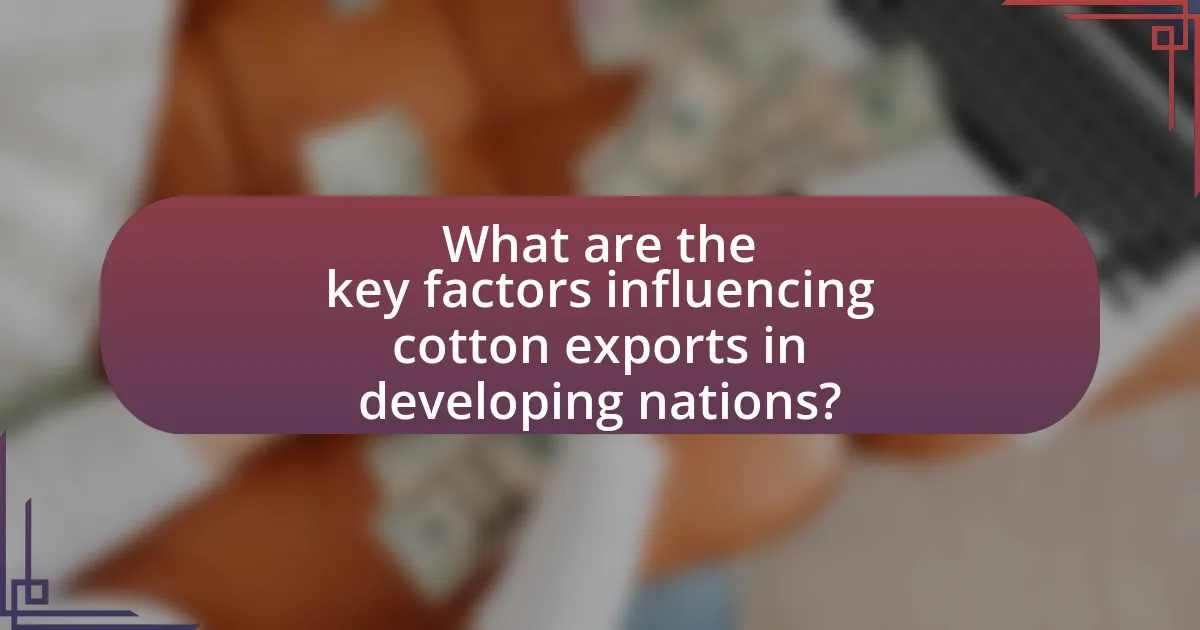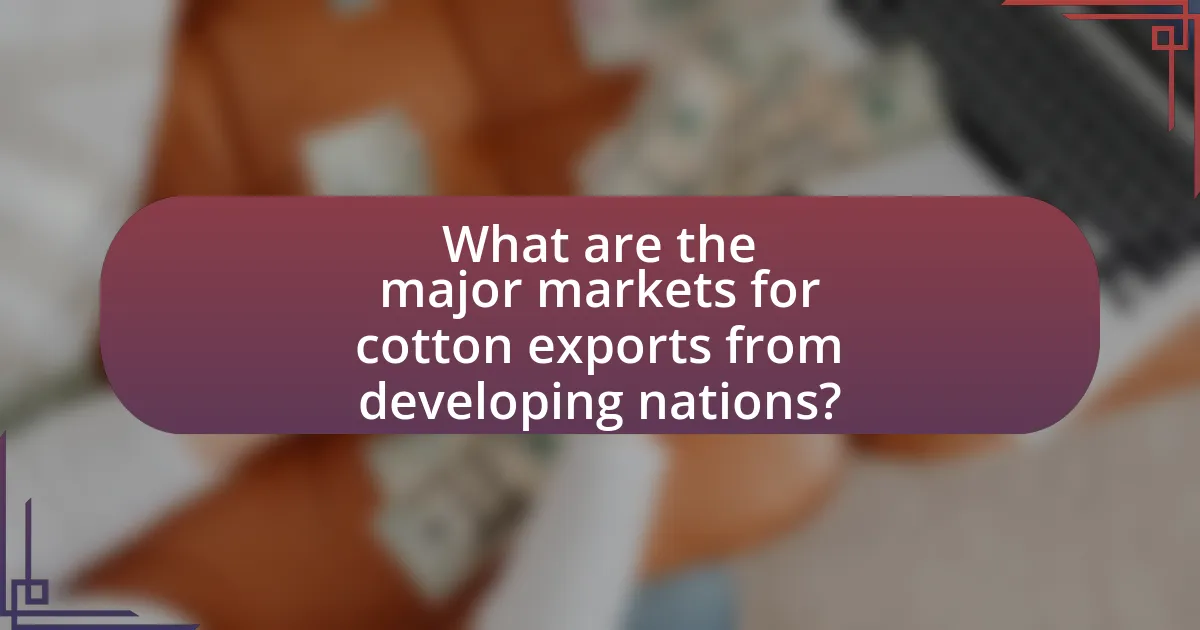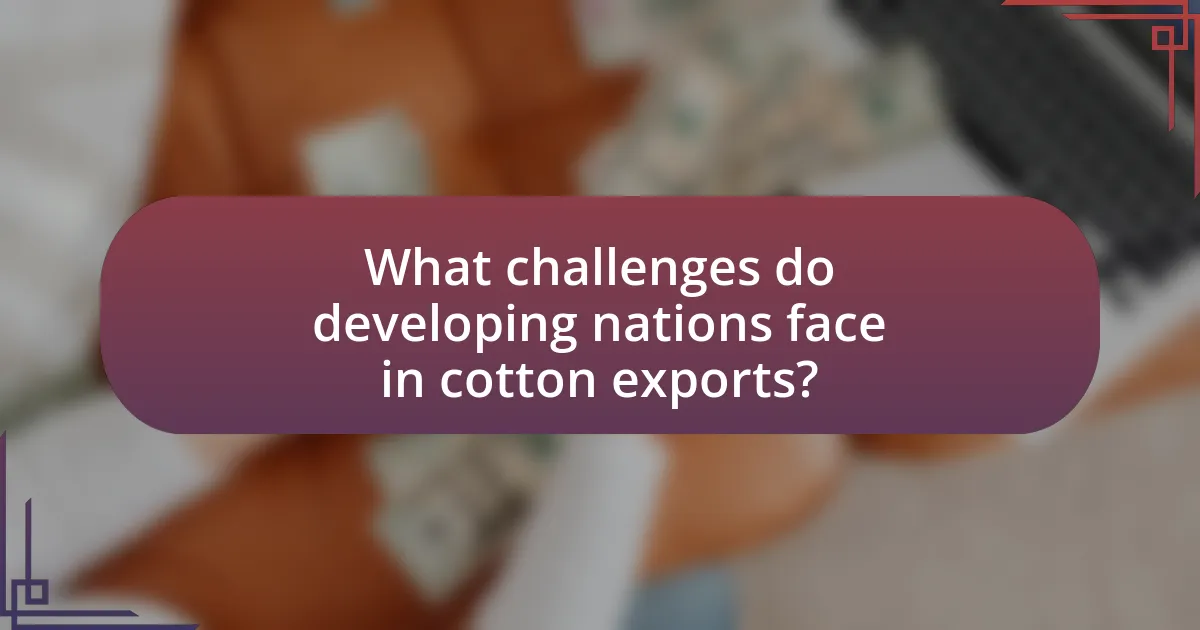The article focuses on cotton exports from developing nations, examining the key factors that influence their performance in the global market. It highlights the importance of production capacity, market access, government policies, and global demand, while also addressing the impact of economic conditions, GDP, inflation rates, and political influences on export levels. Additionally, the article discusses the challenges posed by climate change, infrastructure issues, and financial constraints, as well as the role of international markets and trade agreements in shaping export opportunities. Best practices for enhancing cotton export success, including sustainable farming techniques and market diversification strategies, are also explored.

What are the key factors influencing cotton exports in developing nations?
The key factors influencing cotton exports in developing nations include production capacity, market access, government policies, and global demand. Production capacity is critical, as countries with higher yields and better farming practices can export more cotton. For instance, India and Brazil have significantly increased their cotton production through improved agricultural techniques. Market access is also vital; countries that can enter international markets benefit from trade agreements and lower tariffs, which enhance their export potential. Government policies, such as subsidies and support for farmers, directly impact the competitiveness of cotton exports. Lastly, global demand fluctuates based on consumer preferences and economic conditions, affecting how much cotton developing nations can export. For example, the rise in sustainable fashion has increased demand for organic cotton, benefiting countries that can produce it.
How do economic conditions affect cotton export levels?
Economic conditions significantly influence cotton export levels by affecting production costs, demand, and global market prices. For instance, when economic growth occurs in importing countries, demand for cotton increases, leading to higher export levels from producing nations. Conversely, during economic downturns, reduced consumer spending can lead to decreased demand for cotton products, negatively impacting export volumes. Additionally, fluctuations in currency exchange rates can affect the competitiveness of cotton prices on the global market; a stronger local currency can make exports more expensive, while a weaker currency can enhance export attractiveness. Historical data shows that in 2020, global cotton exports fell by 12% due to the economic impacts of the COVID-19 pandemic, illustrating the direct correlation between economic conditions and export levels.
What role does GDP play in cotton export performance?
GDP significantly influences cotton export performance by reflecting the economic health and production capacity of a country. Higher GDP often correlates with increased investment in agricultural technology and infrastructure, leading to improved cotton yields and quality. For instance, countries like India and China, which have experienced GDP growth, have also seen substantial increases in cotton production and exports, with India exporting approximately 6 million bales in 2021, driven by its economic expansion. This relationship underscores that as GDP rises, so does the potential for enhanced cotton export performance, supported by better resources and market access.
How do inflation rates impact cotton production and exports?
Inflation rates significantly impact cotton production and exports by increasing the cost of inputs and reducing profit margins for farmers. When inflation rises, the prices of seeds, fertilizers, and equipment also increase, leading to higher production costs. For instance, in countries like India, a 10% increase in inflation has been correlated with a 5% rise in cotton production costs, which can deter farmers from investing in cotton cultivation. Additionally, higher inflation can weaken the local currency, making exports less competitive on the global market. For example, when the Indian rupee depreciated due to inflationary pressures, cotton exports fell by 15% as international buyers sought cheaper alternatives. Thus, inflation directly influences both the cost structure of cotton production and the competitiveness of cotton exports.
What are the political influences on cotton exports?
Political influences on cotton exports include government policies, trade agreements, and subsidies that directly affect production and pricing. For instance, in the United States, the Farm Bill provides substantial subsidies to cotton farmers, which can distort market prices and impact global competitiveness. Additionally, international trade agreements, such as the North American Free Trade Agreement (NAFTA), have historically shaped export dynamics by reducing tariffs and fostering trade relationships. Furthermore, political stability in cotton-producing countries can influence export volumes; for example, civil unrest in countries like Mali has led to decreased production and exports. These factors collectively demonstrate how political decisions and conditions can significantly impact the cotton export market.
How do trade policies affect cotton export opportunities?
Trade policies significantly influence cotton export opportunities by determining tariffs, quotas, and subsidies that affect market access and competitiveness. For instance, countries with favorable trade agreements can export cotton at lower tariffs, enhancing their market presence. According to the World Trade Organization, trade policies that reduce barriers can lead to increased cotton exports, as seen in countries like India and Brazil, which have benefited from reduced tariffs in key markets. Additionally, subsidies provided by governments can distort market prices, making it challenging for cotton producers in developing nations to compete effectively on a global scale.
What is the impact of government support on cotton farmers?
Government support significantly enhances the economic stability and productivity of cotton farmers. This support often includes subsidies, access to credit, and investment in agricultural infrastructure, which collectively reduce production costs and increase yields. For instance, in countries like India, government initiatives such as the Minimum Support Price (MSP) have been shown to stabilize farmers’ incomes and encourage higher production levels, leading to a reported increase in cotton output by approximately 20% over the past decade. Additionally, research from the International Cotton Advisory Committee indicates that such support mechanisms can lead to improved market access and competitiveness for cotton farmers in developing nations.
How does climate change affect cotton production in developing nations?
Climate change negatively impacts cotton production in developing nations by altering weather patterns, increasing temperatures, and causing water scarcity. These changes lead to reduced yields, as cotton plants are sensitive to temperature fluctuations and require consistent water supply for optimal growth. For instance, a study by the International Cotton Advisory Committee indicates that a 1°C rise in temperature can decrease cotton yields by up to 10% in some regions. Additionally, erratic rainfall patterns can lead to droughts or floods, further stressing cotton crops and diminishing harvests. Consequently, these factors threaten the livelihoods of farmers in developing nations who rely heavily on cotton as a cash crop.
What are the specific climate challenges faced by cotton farmers?
Cotton farmers face specific climate challenges including increased temperatures, altered precipitation patterns, and extreme weather events. Increased temperatures can lead to heat stress on cotton plants, reducing yields and affecting fiber quality. Altered precipitation patterns can result in droughts or excessive rainfall, both of which negatively impact crop growth and harvest timing. Extreme weather events, such as hurricanes or floods, can cause significant damage to cotton fields and infrastructure. According to the Intergovernmental Panel on Climate Change (IPCC), these climate factors are projected to intensify, posing ongoing risks to cotton production in developing nations.
How can sustainable practices mitigate climate impacts on cotton exports?
Sustainable practices can mitigate climate impacts on cotton exports by reducing water usage, minimizing chemical inputs, and enhancing soil health. For instance, implementing organic farming techniques can decrease reliance on synthetic fertilizers and pesticides, which contribute to greenhouse gas emissions. According to a study by the International Cotton Advisory Committee, adopting sustainable practices can lead to a 30% reduction in water consumption and a significant decrease in carbon emissions associated with cotton production. Additionally, practices such as crop rotation and cover cropping improve soil fertility and resilience, further supporting sustainable cotton exports in developing nations.

What are the major markets for cotton exports from developing nations?
The major markets for cotton exports from developing nations include China, India, and Bangladesh. These countries are significant importers of cotton due to their large textile industries. For instance, China is the largest importer of cotton globally, accounting for approximately 30% of the world’s cotton imports, driven by its extensive manufacturing sector. India and Bangladesh also play crucial roles, with Bangladesh being the second-largest apparel exporter, heavily reliant on cotton imports to meet its production needs. This reliance on cotton from developing nations highlights the interconnectedness of global trade in textiles.
Which countries are the largest importers of cotton?
The largest importers of cotton are China, India, and Bangladesh. In 2021, China accounted for approximately 30% of global cotton imports, followed by India and Bangladesh, which together represented a significant portion of the market. These countries import cotton primarily for their extensive textile industries, which rely heavily on raw cotton to produce garments and other textile products.
What factors drive demand for cotton in these markets?
The demand for cotton in developing markets is primarily driven by the growth of the textile industry, which relies heavily on cotton as a raw material. As countries industrialize, the need for cotton increases due to its use in clothing, home textiles, and other fabric-based products. For instance, according to the International Cotton Advisory Committee, global cotton consumption reached approximately 25 million tons in 2021, with a significant portion attributed to developing nations where textile manufacturing is expanding rapidly. Additionally, rising consumer preferences for natural fibers over synthetic alternatives further bolster cotton demand, as consumers increasingly seek sustainable and eco-friendly products.
How do trade agreements influence cotton export destinations?
Trade agreements significantly influence cotton export destinations by establishing preferential tariffs and trade conditions that favor certain countries over others. For instance, agreements like the African Growth and Opportunity Act (AGOA) enable African nations to export cotton to the United States with reduced tariffs, thereby increasing their competitiveness in the U.S. market. This preferential treatment can redirect cotton exports from countries without such agreements, as seen in the case of Benin and Burkina Faso, which have benefited from AGOA, leading to increased export volumes to the U.S. compared to non-AGOA countries. Additionally, trade agreements can facilitate access to new markets, as seen with the Comprehensive and Progressive Agreement for Trans-Pacific Partnership (CPTPP), which opens up opportunities for cotton exporters in member countries to access markets in Asia and the Americas, further shaping export patterns.
What trends are shaping the global cotton market?
The global cotton market is being shaped by several key trends, including increasing demand for sustainable and organic cotton, fluctuations in global supply due to climate change, and advancements in technology for cotton production. The demand for sustainable cotton has risen significantly, with a 50% increase in organic cotton production reported between 2018 and 2020, driven by consumer preferences for environmentally friendly products. Climate change has led to unpredictable weather patterns, affecting cotton yields in major producing countries like India and the United States, which account for over 50% of global cotton production. Additionally, technological innovations, such as precision agriculture and genetically modified cotton varieties, are enhancing productivity and resilience, further influencing market dynamics. These trends collectively impact pricing, trade policies, and the economic viability of cotton exports, particularly for developing nations reliant on cotton as a key export commodity.
How is consumer preference changing in relation to cotton products?
Consumer preference is shifting towards sustainable and organic cotton products. This change is driven by increasing awareness of environmental issues and the desire for ethically sourced materials. According to a 2021 survey by McKinsey & Company, 67% of consumers consider sustainability when making a purchase, indicating a significant trend towards eco-friendly cotton options. Additionally, the global organic cotton market is projected to grow at a CAGR of 10% from 2021 to 2026, reflecting a strong consumer demand for organic alternatives.
What technological advancements are impacting cotton trade?
Technological advancements significantly impacting cotton trade include precision agriculture, blockchain technology, and data analytics. Precision agriculture utilizes GPS and IoT devices to optimize planting, irrigation, and harvesting, leading to increased yields and reduced resource waste. Blockchain technology enhances transparency and traceability in the supply chain, allowing stakeholders to verify the origin and quality of cotton, which is crucial for meeting consumer demand for sustainable practices. Data analytics enables better market forecasting and pricing strategies, helping farmers and traders make informed decisions. These advancements collectively improve efficiency, sustainability, and profitability in the cotton trade.

What challenges do developing nations face in cotton exports?
Developing nations face significant challenges in cotton exports, primarily due to limited access to technology and financing. These countries often lack the advanced agricultural practices and equipment necessary for efficient cotton production, which results in lower yields compared to developed nations. For instance, according to the Food and Agriculture Organization, many developing countries have an average yield of around 500 kg per hectare, while developed countries can achieve yields exceeding 1,000 kg per hectare.
Additionally, developing nations frequently encounter issues related to market access and trade barriers. Tariffs and subsidies imposed by developed countries can hinder the competitiveness of cotton from developing nations. The World Trade Organization reports that cotton subsidies in the United States and the European Union distort global prices, making it difficult for producers in developing countries to compete effectively.
Furthermore, inadequate infrastructure, such as poor transportation and storage facilities, exacerbates the challenges faced by these nations, leading to increased post-harvest losses. The combination of these factors significantly impacts the ability of developing nations to export cotton successfully.
How do infrastructure issues affect cotton export efficiency?
Infrastructure issues significantly hinder cotton export efficiency by causing delays and increasing costs. Poor transportation networks, such as inadequate roads and insufficient port facilities, lead to longer transit times for cotton shipments, which can result in missed market opportunities and spoilage. For instance, a study by the World Bank indicated that countries with underdeveloped infrastructure experience up to a 30% increase in logistics costs, directly impacting the competitiveness of their cotton exports. Additionally, unreliable power supply can disrupt processing facilities, further delaying the export process. Thus, the state of infrastructure directly correlates with the efficiency of cotton exports in developing nations.
What are the key infrastructural barriers for cotton transportation?
The key infrastructural barriers for cotton transportation include inadequate road and rail networks, insufficient storage facilities, and limited access to ports. In many developing nations, the road infrastructure is often poorly maintained, leading to delays and increased transportation costs. Rail networks may be underdeveloped or non-existent, which restricts efficient bulk transport of cotton. Additionally, a lack of proper storage facilities can result in quality degradation during transit, while limited access to ports can hinder timely export, affecting the competitiveness of cotton in global markets. These barriers collectively impede the smooth flow of cotton from farms to international markets, impacting the economic viability of cotton exports in developing nations.
How can improving infrastructure enhance export capabilities?
Improving infrastructure enhances export capabilities by facilitating efficient transportation and logistics, which reduces costs and delivery times. For instance, well-maintained roads, ports, and rail systems enable quicker movement of cotton from farms to markets, increasing competitiveness in global trade. According to the World Bank, countries with better infrastructure can reduce trade costs by up to 15%, directly impacting export volumes. Enhanced infrastructure also attracts foreign investment, leading to technological advancements and improved production processes, further boosting export potential.
What are the financial challenges faced by cotton exporters?
Cotton exporters face several financial challenges, including fluctuating global prices, high production costs, and limited access to financing. Fluctuating global prices can significantly impact revenue, as cotton prices are subject to market volatility influenced by supply and demand dynamics. High production costs, driven by factors such as labor, fertilizers, and pest control, further strain profit margins. Additionally, many exporters in developing nations struggle with limited access to financing options, which restricts their ability to invest in technology and improve production efficiency. According to the International Cotton Advisory Committee, these challenges can lead to reduced competitiveness in the global market, making it difficult for exporters to sustain their operations.
How do access to credit and financing impact cotton production?
Access to credit and financing significantly enhances cotton production by enabling farmers to invest in necessary inputs such as seeds, fertilizers, and equipment. When farmers have access to financial resources, they can adopt modern agricultural practices and technologies that increase yield and efficiency. For instance, a study by the International Cotton Advisory Committee found that countries with better access to credit saw an increase in cotton yields by up to 30% compared to those with limited financing options. This correlation highlights the critical role that financial support plays in improving agricultural productivity and, consequently, the overall cotton export capacity of developing nations.
What role do international markets play in pricing challenges for exporters?
International markets significantly influence pricing challenges for exporters by introducing volatility and competition. Exporters face fluctuating prices due to global supply and demand dynamics, which can be affected by factors such as trade policies, currency exchange rates, and market access. For instance, the International Cotton Advisory Committee reported that cotton prices can vary widely based on international market conditions, impacting the profitability of exporters from developing nations. Additionally, competition from other countries can drive prices down, forcing exporters to adapt their pricing strategies to remain competitive.
What best practices can enhance cotton export success in developing nations?
To enhance cotton export success in developing nations, implementing quality control measures is essential. Ensuring that cotton meets international standards can significantly increase its marketability. For instance, countries like India and Brazil have adopted stringent grading systems that improve the quality of their cotton, leading to higher prices and better export opportunities. Additionally, investing in infrastructure, such as transportation and storage facilities, facilitates timely delivery and reduces post-harvest losses, which is crucial for maintaining quality. Furthermore, establishing strong trade relationships and participating in international trade fairs can open new markets and attract buyers. According to the International Cotton Advisory Committee, countries that engage in these practices see a marked increase in their export volumes and revenues.
How can farmers adopt sustainable practices to improve yield?
Farmers can adopt sustainable practices to improve yield by implementing crop rotation, integrated pest management, and organic farming techniques. Crop rotation enhances soil fertility and reduces pest and disease cycles, leading to healthier crops and increased yields. Integrated pest management minimizes chemical use by combining biological control, habitat manipulation, and resistant varieties, which can lead to better pest control and reduced costs. Organic farming techniques, such as using compost and natural fertilizers, improve soil health and promote biodiversity, resulting in higher productivity. Research indicates that these practices can increase yields by 20-30% while also promoting environmental sustainability.
What strategies can exporters use to navigate global market challenges?
Exporters can navigate global market challenges by diversifying their markets, enhancing product quality, and leveraging technology. Diversification reduces dependency on a single market, mitigating risks associated with economic fluctuations; for instance, exporters from developing nations can target multiple regions such as Asia, Europe, and Africa to spread their risk. Enhancing product quality ensures competitiveness in international markets, as higher quality cotton can command better prices and attract more buyers. Leveraging technology, such as e-commerce platforms and data analytics, allows exporters to reach broader audiences and optimize their supply chains, improving efficiency and responsiveness to market demands. These strategies are supported by the fact that countries like India and Brazil have successfully increased their cotton exports by implementing similar approaches, demonstrating their effectiveness in overcoming global market challenges.





